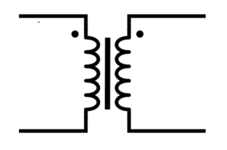It is a common concern of technicians to adapt equipment manufactured on countries whose frequency of electric public mains differs from its local, so that a modification becomes necessary, but depending on the size of equipment, the cost of the transformer may be the largest when compared to the other devices, and the following study can help determine the feasibility of conducting such a change. Obviously, this also determine if the power sizing is adequate to the load consumption.
For many people, the difference of only 10 Hz in the operating frequency could be something considered within reasonable tolerance range on the power electronics, but the algebraic development below attempts to accurately determine the impact of this increase, obviously taking as the main requirement, handling the same input voltage and power in both cases.
It is well known that the main factor that determine the price of a transformer is its weigh. There is some almost linear proportion regarding to the weigh and cost of a transformer, so that we can assume the calculus bellow as a good approximation to estimate.
To determine what is such a relation we start by applying Faraday's law, obtaining:
Erms ≅ 2 π f N A Bpeak / √2
Considering that either on 60Hz or 50Hz frequencies f,the rate Volt/Spires (E/N)|f of the transformer must remains the same to a given E input for each case, we can set it as a constant:
E/N = 4.44 f A B
What implies on existence of a relation bellow:
( (E/N)|50Hz / (E/N)|60Hz ) = constant
In order to assure the same performance in energy losses by internal dissipation due to core saturation, we also define the same maximum magnetic flow B for both frequencies, setting as a constant:
E/N.B = 4.44 f A
Therefore, for a rated voltage E, a maximum magnetic flux B, and a settled number of spires N, the equality bellow must be the same for each transformer:
f.A = constant
Assuming A_50 and A_60 terms as the cross-sectional areas that both 50Hz and 60Hz transformers should have for the frequencies of 50Hz and 60Hz; Increasing the operating frequency from 50Hz to 60Hz will have an increase of 20% (60/50 = 1.2) on the original cross-sectional area:
(50).A_50 = (60).A_60
A_50 / A_60 = 1.2
However, as defined on the geometry fundamentals, the rate of an area of a section of a generic object against his volume follows a relationship:
A3~ V2
Therefore, assuming that we will use the same type of transformer ( EE, EI, Toroidal, etc... ) which is linearly scaled on size, the accretion of 1.2 would result in a volume increase of:
V_50 / V_60 = (1.2)(3/2) = 1.31
Therefore, the weight increase is in the order of 1/3 of the current weight !
For many people, the difference of only 10 Hz in the operating frequency could be something considered within reasonable tolerance range on the power electronics, but the algebraic development below attempts to accurately determine the impact of this increase, obviously taking as the main requirement, handling the same input voltage and power in both cases.
It is well known that the main factor that determine the price of a transformer is its weigh. There is some almost linear proportion regarding to the weigh and cost of a transformer, so that we can assume the calculus bellow as a good approximation to estimate.
To determine what is such a relation we start by applying Faraday's law, obtaining:
Erms ≅ 2 π f N A Bpeak / √2
Considering that either on 60Hz or 50Hz frequencies f,the rate Volt/Spires (E/N)|f of the transformer must remains the same to a given E input for each case, we can set it as a constant:
E/N = 4.44 f A B
What implies on existence of a relation bellow:
( (E/N)|50Hz / (E/N)|60Hz ) = constant
In order to assure the same performance in energy losses by internal dissipation due to core saturation, we also define the same maximum magnetic flow B for both frequencies, setting as a constant:
E/N.B = 4.44 f A
Therefore, for a rated voltage E, a maximum magnetic flux B, and a settled number of spires N, the equality bellow must be the same for each transformer:
f.A = constant
Assuming A_50 and A_60 terms as the cross-sectional areas that both 50Hz and 60Hz transformers should have for the frequencies of 50Hz and 60Hz; Increasing the operating frequency from 50Hz to 60Hz will have an increase of 20% (60/50 = 1.2) on the original cross-sectional area:
(50).A_50 = (60).A_60
A_50 / A_60 = 1.2
However, as defined on the geometry fundamentals, the rate of an area of a section of a generic object against his volume follows a relationship:
A3~ V2
Therefore, assuming that we will use the same type of transformer ( EE, EI, Toroidal, etc... ) which is linearly scaled on size, the accretion of 1.2 would result in a volume increase of:
V_50 / V_60 = (1.2)(3/2) = 1.31
Therefore, the weight increase is in the order of 1/3 of the current weight !
